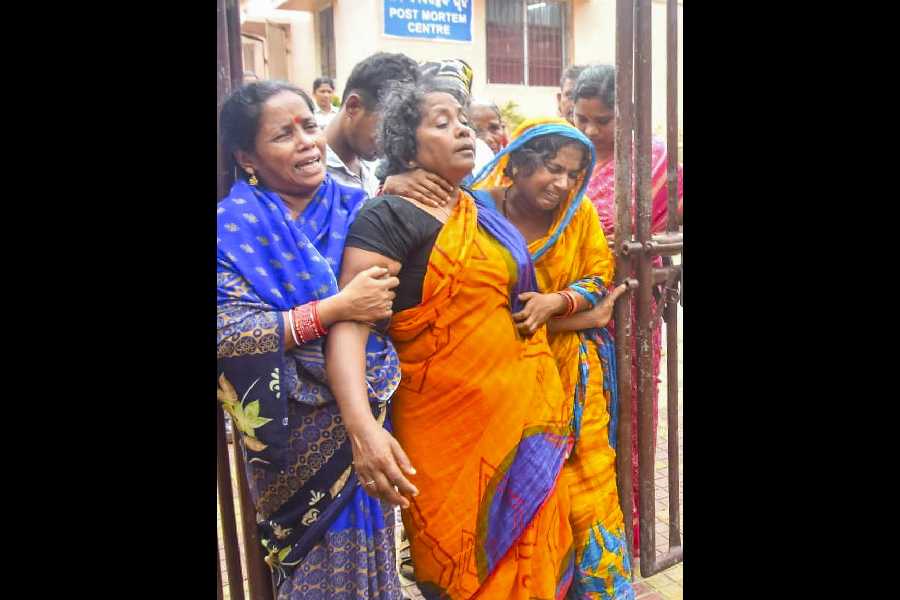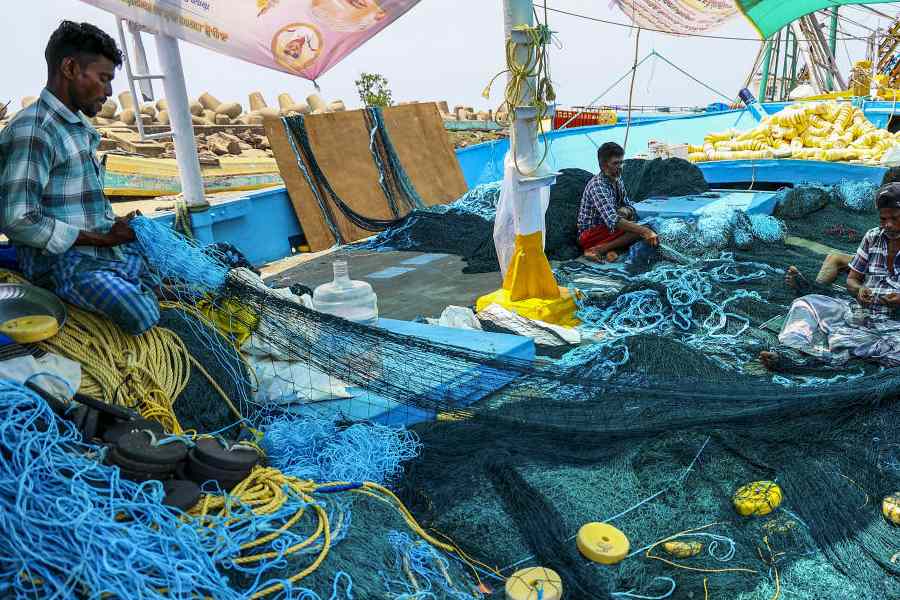 |
“You can script fairy tales on clothes.” — Mahatma Gandhi to weavers during his maiden visit to Sualkuchi in 1946
Sarat Kalita is one such, a weaver of fairy tales. Yet, in circa 2014, Kalita survives on nimox bhat (rice and salt). His home is a dilapidated, sweaty bamboo-tin shack that on a muggy day well qualifies to the visitor as intolerable. Yet there he sat, weaving his glowing flowers onto exquisite mekhela sador sets. Sometimes he gets work, sometimes he doesn’t, his average monthly income a mere Rs 3,000.
“The orders (from clients) have dried up and two of my three looms invariably lie idle. Things have come to such a pass that we (a family of four) virtually eat nothing,” the weaver said, as his nimble fingers effortlessly weave his dream for the day, a combination of small maroon flowers on a shiny muga sador, his bare worn-out feet keep time on the treadles of his rickety loom.
There’s a certain singeing fire in Kalita’s little maroon flowers, the 67-year-old was one of the several hundreds to have hit the streets against Benarasi silk flooding Assam’s silk town a year back, the “revolution” as they call it now, a balance sheet of where Assam’s silk industry stands.
Sualkuchi, 35km from Guwahati in Kamrup (rural) district, produces 31,000 lakh linear metres of silk fabrics worth Rs 90 crore, with an approximate annual export of Rs 120 crore.
The April 24 elections and the affairs of the state don’t evoke a reaction. “I will vote if I get the time,” said Kalita. “For us, it’s about having something to weave and making ends meet. The elections hardly matter,” he added.
Kalitapara, where he hails from, has another 40-odd families living a hand-to-mouth existence, their workplaces cramped, cobwebbed and creaky.
The lack of lustre is all pervading. The cluster of silk shops at Na-para, the commercial hub of the town, waits for the first sador to be sold as half a day goes by. And as if to “add life” to the sombre ambience, there’s Udit Narayan’s Bin Tere Sanam Mar Mitenge Hum and no lyrical love song Bihu that marks the onset of spring in Assam.
The mood in a town known to the world for its magical weaves is far from upbeat...the spirits all but “Rongali” (colourful). At first sight as another election approaches, this time coinciding with Bohag — the season of Bihu, the mind ponders whether polls are playing spoilsport.
Rise in the cost of yarn and shortage of xipinis (weavers) are hitting the trade hard. The yarn from mulberry leaves (pat) has to be procured from Bangalore, muga from Upper Assam and tassar from Jharkhand. That’s because, despite the availability of cocoons here, Sualkuchi does not have the machines to process quality yarn.
“The cost of yarn has gone up by at least 60 per cent in the past 12 months. For instance, a kg of two-ply (having two strands) yarn now costs Rs 6,500 as against Rs 2,700 a year back. To add to it, a majority (95 per cent) of our xipinis are from outside town and not too many are there at our disposal,” said Hiralal Kalita, master weaver and secretary of the Sualkuchi Tat Silpa Unnayan Samiti.
The figures say it all as well. The number of looms in the town has come down from 25,000 about a decade back to 12,100 now. The twin problems of rising cost of production and dearth of weavers, many here said, had only encouraged traders to bring in more Benarasi products last year.
The samiti was formed after the “revolution”, as a measure to protect Assam silk from the onslaught of cheaper silk made outside. “Since the violence last year, we have told traders and weavers here that our strength lies in our tradition and we cannot allow silk made outside to be sold here at a cheaper rate. None of the shops now sell mekhela sador made in Islampur and Mubarakpur (Uttar Pradesh). We have also applied for a trademark for clothes made only in Sualkuchi and by October the Patent and Trademark Bureau is expected to clear our proposal,” the secretary of the samiti said.
Silk weaving provides direct as well as indirect employment to more than 25,000 people throughout the year in Assam. Over 12,000 of them are women weavers. Seventy per cent of the products comprise mekhela and sador, 20 per cent silk sarees and 10 per cent comprise stoles, scarves, bedsheets and even drapery.
Hiralal, for his part, is also practising what he on behalf of the samiti is preaching at a time when greener pastures outside town are weaning away youths from carrying forward a legacy and preserving their identity.
“I have diversified from weaving mekhela to creating stoles, scarves, ties, handbags and even silk drapery that tourists come here seeking. I have a decent foreign clientele during November and March and that’s where bulk of my profits comes from. So I tell youngsters to follow suit and not be lured by jobs outside,” said the 40-year-old who will attend a conference on Assam’s muga in the US in July.
But for now, the 70-odd silk shops of “Bastranagari”, known for its work-is-worship culture as the welcome gate says, are witnessing an unprecedented lull in business. Lack of regulation and failed promises have left people distraught and disenchanted.
Apparently, there is an anti-incumbency sentiment blowing in the air with many, young and old, hoping for a poriborton (change) after the April 24 elections, a change which will improve their lot.
“The government has done precious little. We do not have a yarn bank here where we can get subsidies on yarn procured. Nor do we have a cloth bank where we can get a fair price during the off-season. The schemes promised by the local MLA have not been implemented,” said Dilip Kalita, 36, proprietor of Jayanti Silk Centre at Na-para.
The town was once an AGP bastion till the Congress took over.
“We used to burn the midnight oil during Bihu. Now, most of us are forced to sit idle, our livelihoods are at stake. Things have changed but the government hasn’t. Come April 24, we will vote for a change,” said Girish Kalita, 72, another weaver, as a group of inquisitive villagers milling around nod their heads in approval.
The effect is cascading. Even as there is no dearth of work culture here, the slackness is noticeable at Lal Handloom Dyeing Centre, a few yards away from the block development office (BDO) campus.
“Work time has gone down by half than what it was four years ago. Over and above, the cost of chemical dyes has gone up three fold. I am even planning to downsize my workforce to cut cost. It’s sad but the government only talks big and does nothing,” said Apurba Lal Baishya, proprietor of the dyeing centre.
The Bastranagari is struggling to limp back to the “fairy tale” days even as it hopes for a magic potion in the form a poriborton in the political milieu.
Sualkuchi, under Gauhati parliamentary constituency, votes on April 24











